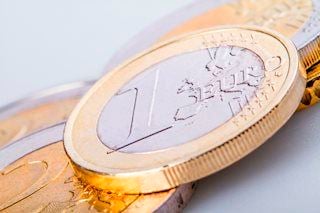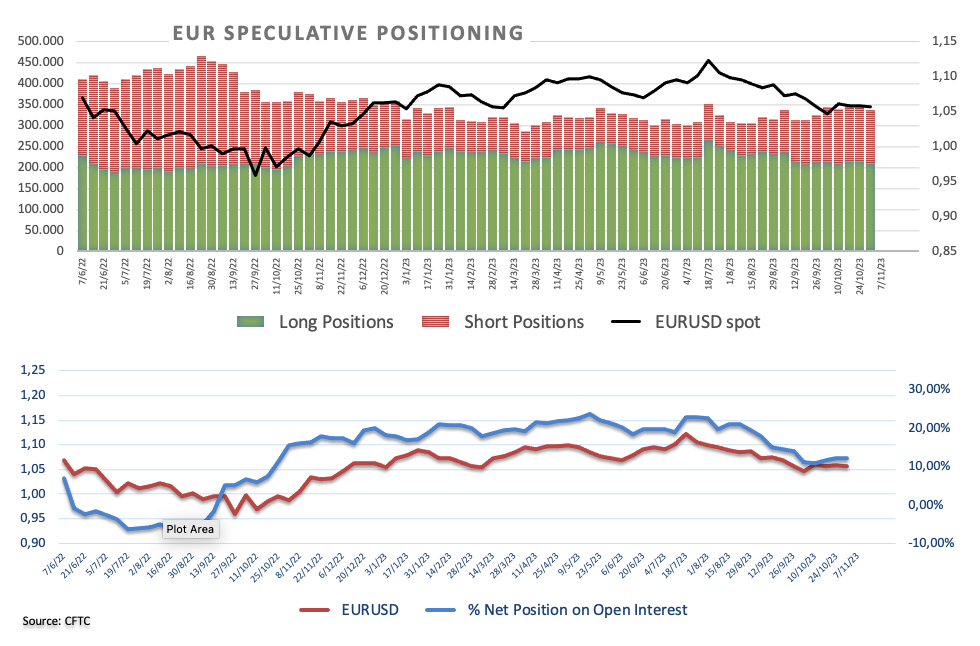Euro trims some gains and returns to 1.0740
|
- The Euro maintains the constructive stance vs. the US Dollar.
- European markets face a negative close on Monday.
- EMU Sentix Index rebounds in November.
At the start of the week, the Euro (EUR) maintains a strong and optimistic outlook in comparison to the US Dollar (USD), pushing EUR/USD to eight-week highs around 1.0760, where some initial resistance appears to have turned up.
In contrast, the Greenback is facing increased downward pressure, causing the USD Index (DXY) to fall below the critical support level of 105.00. This drop in the value of the Greenback is occurring amidst a widespread improvement in risk-related assets. Interestingly, this decline in the index contradicts a modest recovery in US interest rates across various maturity periods.
In the context of monetary policy, a growing consensus has formed amongst market participants that the Federal Reserve (Fed) will probably maintain its present monetary conditions unchanged for the interim, as the potential for a rate amendment in December seems to have lost some impetus particularly in the aftermath of the latest FOMC meeting and Friday's publication of weaker-than-anticipated Nonfarm Payrolls for the month of October.
The European Central Bank (ECB) is likely to follow suit, as investors now favour a protracted hiatus of its tightening campaign, most likely until the latter half of the subsequent year.
From the speculators' view, net longs in EUR rose to five-week highs in the week to October 31 according to the CFTC Positioning Report. During that period, the pair traded within a range bound theme ahead of the ECB event and amidst speculation of a potential rate hike by the Fed by year-end.
On the euro data docket, Germany’s final Services PMI came in at 48.2, and 47.8 when it came to the broader euro area. In addition, Investor Confidence tracked by the Sentix index improved to -18.6 for the euro bloc in November and Factory Orders in Germany expanded 0.2% MoM in September.
In the US, FOMC Governor Lisa Cook (permanent voter, centrist), is due to speak later in the session.
Daily digest market movers: Euro extends the march north on weaker Dollar
- The EUR looks to consolidate the breakout of 1.0700 vs. the USD.
- US and German yields regain some composure on Monday.
- Markets now see the Fed refraining from hiking rates in December.
- The ECB could extend its pause until H2 2024.
- The crisis in the Middle East threatens to extend to other regions.
- BoJ Kazuo Ueda favoured the continuation of large-scale bond purchases.
Technical Analysis: Euro faces a minor hurdle near 1.0770
EUR/USD accelerates its recent gains and advances to eight-week tops near 1.0760 on Monday.
The weekly peak of 1.0767 (September 12) comes before the important 200-day SMA at 1.0805 for EUR/USD, while another weekly high of 1.0945 (August 30) occurs before the psychological barrier of 1.1000. Beyond this zone, the pair may face resistance at the August top of 1.1064 (August 10), followed by the weekly peak of 1.1149 (July 27) and the 2023 high of 1.1275 (July 18).
Sellers, on the other hand, are likely to face the next contention at the weekly low of 1.0495 (October 13), prior to reaching the 2023 bottom at 1.0448 (October 15), and the round number of 1.0400.
Meanwhile, the pair's outlook is expected to stay negative as long as it remains below the 200-day SMA.
Euro FAQs
What is the Euro?
The Euro is the currency for the 20 European Union countries that belong to the Eurozone. It is the second most heavily traded currency in the world behind the US Dollar. In 2022, it accounted for 31% of all foreign exchange transactions, with an average daily turnover of over $2.2 trillion a day.
EUR/USD is the most heavily traded currency pair in the world, accounting for an estimated 30% off all transactions, followed by EUR/JPY (4%), EUR/GBP (3%) and EUR/AUD (2%).
What is the ECB and how does it impact the Euro?
The European Central Bank (ECB) in Frankfurt, Germany, is the reserve bank for the Eurozone. The ECB sets interest rates and manages monetary policy.
The ECB’s primary mandate is to maintain price stability, which means either controlling inflation or stimulating growth. Its primary tool is the raising or lowering of interest rates. Relatively high interest rates – or the expectation of higher rates – will usually benefit the Euro and vice versa.
The ECB Governing Council makes monetary policy decisions at meetings held eight times a year. Decisions are made by heads of the Eurozone national banks and six permanent members, including the President of the ECB, Christine Lagarde.
How does inflation data impact the value of the Euro?
Eurozone inflation data, measured by the Harmonized Index of Consumer Prices (HICP), is an important econometric for the Euro. If inflation rises more than expected, especially if above the ECB’s 2% target, it obliges the ECB to raise interest rates to bring it back under control.
Relatively high interest rates compared to its counterparts will usually benefit the Euro, as it makes the region more attractive as a place for global investors to park their money.
How does economic data influence the value of the Euro?
Data releases gauge the health of the economy and can impact on the Euro. Indicators such as GDP, Manufacturing and Services PMIs, employment, and consumer sentiment surveys can all influence the direction of the single currency.
A strong economy is good for the Euro. Not only does it attract more foreign investment but it may encourage the ECB to put up interest rates, which will directly strengthen the Euro. Otherwise, if economic data is weak, the Euro is likely to fall.
Economic data for the four largest economies in the euro area (Germany, France, Italy and Spain) are especially significant, as they account for 75% of the Eurozone’s economy.
How does the Trade Balance impact the Euro?
Another significant data release for the Euro is the Trade Balance. This indicator measures the difference between what a country earns from its exports and what it spends on imports over a given period.
If a country produces highly sought after exports then its currency will gain in value purely from the extra demand created from foreign buyers seeking to purchase these goods. Therefore, a positive net Trade Balance strengthens a currency and vice versa for a negative balance.
Information on these pages contains forward-looking statements that involve risks and uncertainties. Markets and instruments profiled on this page are for informational purposes only and should not in any way come across as a recommendation to buy or sell in these assets. You should do your own thorough research before making any investment decisions. FXStreet does not in any way guarantee that this information is free from mistakes, errors, or material misstatements. It also does not guarantee that this information is of a timely nature. Investing in Open Markets involves a great deal of risk, including the loss of all or a portion of your investment, as well as emotional distress. All risks, losses and costs associated with investing, including total loss of principal, are your responsibility. The views and opinions expressed in this article are those of the authors and do not necessarily reflect the official policy or position of FXStreet nor its advertisers.
